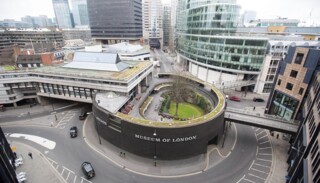Pastures Grey
Gillian Darley
The little circular garden skyed high over the traffic flow on London Wall that currently leads to the entrance to the (soon to be relocated) Museum of London is to be reimagined as ‘The Meadow’. Diller Scofidio + Renfro, the New York architects of the High Line, know a bit about bringing pasture into the city. They also designed Zaryadye Park, a.k.a. ‘Putin’s Paradise’, thirty-five acres of ‘wild urbanism’ in the middle of Moscow, completed in 2017.
When Powell & Moya (not to be confused with Chamberlin Powell & Bon who did the Barbican) designed the Museum of London (which opened in 1977), the site was typical SLOAP (Space Left Over After Planning) next to a 17-storey office block, Bastion House. Michael Brawne reviewed the museum in the Architectural Review in July 1977, calling it ‘the most retiring public building in London’. The reticence was compounded by the ‘quiet inner garden’ and the lack of easily visible exterior elevations. The location, accessed by the aerial city walkways of the 1950s, with ever more heavily burdened road systems threaded through below and around it, allowed for a change of gear. Once inside, it offered a sense of theatre and Brawne went so far as to describe the interior spiral circulation as ‘a kind of Guggenheim in reverse’.
Now that the museum is moving to Smithfield, despite an ongoing disagreement between the meat traders and the City of London Corporation which may yet delay things, the curious snail-shell to be found at the end of London Wall West surely deserves a redesign and a new purpose that can put imagination and zest into those coiling spaces below. As a location for an ambitious ideas competition, it looks ideal. The City Corporation might even want to remind themselves of previous studies, including the 1997 appraisal of Bastion House by Pringle Richards Sharratt, or reconsider the enormous waste of valuable space devoted to two storeys of underused car parking below the wider Barbican. Time to think outside the chassis.
When their earlier scheme for the site, the Centre for Music dreamed of by Simon Rattle, foundered, the architects were happy enough to shift focus and the City Corporation was back in pocket after the £288 million project was shelved. DS+R sent the City renderings of a ‘Tower-Studded Vision’ for the commercial redevelopment of the site, starting with two very dominant new office blocks. To clear the path, Powell & Moya’s Bastion House and the museum below were granted that curious honour, a five-year certificate of immunity from listing, which will remain in place until August 2024. An American bank is rumoured to be interested.
Meanwhile the Barbican Association, those who live there, are mounting a strenuous fight. A poll showed 88 per cent of residents opposed to demolition. The City Corporation, which essentially grants itself planning permission, has so far run rough-shod over the views of locals. As Peter Jenkinson put it at a recent protest meeting, ‘everyone I’ve spoken to agrees that the consultation process has been a joke, a total farce, patronising and dishonest.’ No alternatives have been invited or aired, objections and questions meet a blank wall. The situation looks like an impasse.
Yet the site is too important to be treated as a cash cow. It is important for the built quality of the Barbican as a whole, for the people who live and work there, and as somewhere to right a few wrongs in the parlous City environment, with its wind tunnels, dead trees and frequently dispiriting architecture. The City of London often seems an object lesson in bad practice and calculated obduracy when it could be an object lesson in best practice and enlightened policy for the attention and admiration of every authority in the country. For a start, some more democracy in its governance wouldn’t go amiss.

Comments